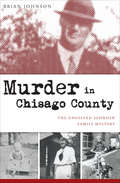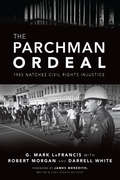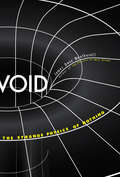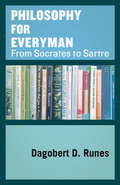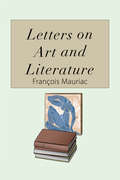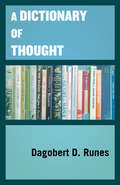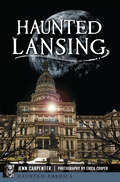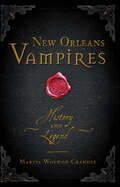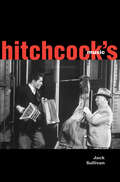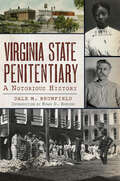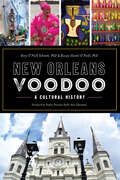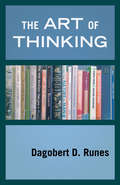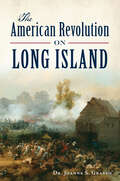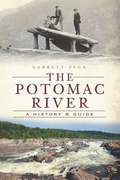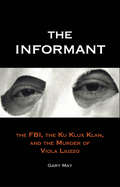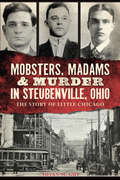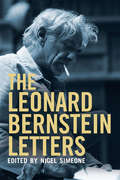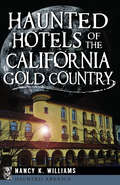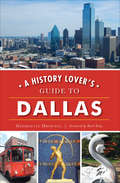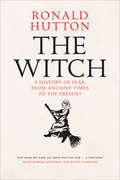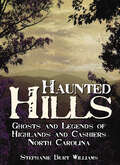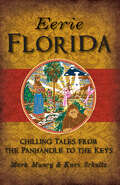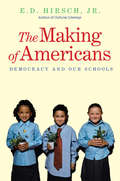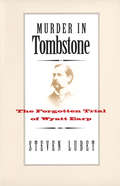- Table View
- List View
Murder in Chisago County: The Unsolved Johnson Family Mystery (True Crime Ser.)
by Brian JohnsonA Minnesota journalist breaks down the cold case that has beguiled a community and haunted his family for generations. At 3:30 a.m. on April 11, 1933, neighbors and firefighters arrived at the farmhouse of Albin and Alvira Johnson to find a smoldering heap where a seemingly happy home once stood. Beneath the ruins, investigators found the bodies of Alvira and her seven children, but Albin's remains were nowhere to be seen. The authorities determined that Alvira and the children were dead before the fire, and fingers immediately pointed to Albin. Hundreds of searchers, including the illustrious Pinkerton Agency, combed the area and even crossed into Canada in pursuit of Johnson, who was indicted in absentia for murder. But he was never found, dead or alive. What happened to the Johnson family and what part, if any, Albin played in the tragedy remain a mystery . . .
The Parchman Ordeal: 1965 Natchez Civil Rights Injustice (True Crime)
by Robert Morgan G. Mark LaFrancis Darrell WhiteAn account of the civil rights march that ended in the unlawful incarceration of African American protestors—and the basis for the 2017 documentary. In October 1965, nearly 800 young people attempted to march from their churches in Natchez to protest segregation, discrimination and mistreatment by white leaders and elements of the Ku Klux Klan. As they exited the churches, local authorities forced the would-be marchers onto buses and charged them with &“parading without a permit,&” a local ordinance later ruled unconstitutional. For approximately 150 of these young men and women, this was only the beginning. They were taken to the Mississippi State Penitentiary in Parchman, where prison authorities subjected them to days of abuse, humiliation and punishment under horrific conditions. Most were African Americans in their teens and early twenties. Authors G. Mark LaFrancis, Robert Morgan and Darrell White reveal the injustice of this overlooked dramatic episode in civil rights history. &“White and Galen Mark LaFrancis are in the process of filming a documentary to shed light on the Parchman Ordeal, which, along with other Natchez stories—like the 1967 Ku Klux Klan slaying of Wharlest Jackson—has flown below the nation&’s radar.&”—The Root &“Could help shed more light on the incident and its place in the nation&’s civil rights history.&”—The Natchez Democrat
Void: The Strange Physics of Nothing (Foundational Questions in Science)
by James Owen WeatherallThe New York Times bestselling author of The Physics of Wall Street &“deftly explains all you wanted to know about nothingness—a.k.a. the quantum vacuum&” (Priyamvada Natarajan, author of Mapping the Heavens). James Owen Weatherall&’s bestselling book, The Physics of Wall Street, was named one of Physics Today&’s five most intriguing books of 2013. In this work, he takes on a fundamental concept of modern physics: nothing. The physics of stuff—protons, neutrons, electrons, and even quarks and gluons—is at least somewhat familiar to most of us. But what about the physics of nothing? Isaac Newton thought of empty space as nothingness extended in all directions, a kind of theater in which physics could unfold. But both quantum theory and relativity tell us that Newton&’s picture can&’t be right. Nothing, it turns out, is an awful lot like something, with a structure and properties every bit as complex and mysterious as matter. In his signature lively prose, Weatherall explores the very nature of empty space—and solidifies his reputation as a science writer to watch. Included on the 2017 Best Book List by the American Association for the Advancement of Science (AAAS) &“An engaging and interesting account.&”—The Economist &“Readers get a dose of biography while following such figures as Einstein, Dirac, and Newton to see how top theories about the void have been discovered, developed, and debunked. Weatherall&’s clear language and skillful organization adroitly combines history and physics to show readers just how much &‘nothing really matters.&’&”—Publishers Weekly
Philosophy for Everyman: From Socrates to Sartre
by Dagobert D. RunesThis sweeping history of philosophy by the author and founder of the Philosophical Library ranges from the pre-Socratics to existentialism. In this historical survey, Dagobert D. Runes introduces readers to the major developments in philosophical inquiry that began with the ancient Greeks. In clear and accessible prose, he traces the progression of thought through influential figures such as Jesus, Muhammad, Francis Bacon, and René Descartes. He also covers a chronology of movements from the Stoics and Epicureans to the Enlightenment, logical positivism, and existentialism. The founder and publisher of the Philosophical Library, Runes is both a philosopher and a scholar of philosophical history. In Philosophy for Everyman: From Socrates to Sartre, he carefully breaks down the key concepts of philosophy for the general reader.
Letters on Art and Literature (Essay And General Literature Index Reprint Ser.)
by François MauriacThe Nobel Prize–winning author of Thérèse Desqueyroux shares fascinating insights through correspondence with Albert Camus, Jean Cocteau, and others. Best known as France&’s great Catholic novelist, François Mauriac was also a playwright, poet, critic, journalist, and member of the Académie Française. He was an influential public intellectual who criticized the Catholic church for supporting Francisco Franco and opposed French rule in Vietnam. As a columnist for Le Figaro, Mauriac engaged in a famous dispute with Albert Camus about the course of France after its liberation from Nazi occupation. In this collection of letters, Mauriac delves into a variety of topics—from the death of Georges Bernanos to the correspondence between Paul Claudel and Andre Gide, and the Routier youth movement—in exchanges with fellow authors, artists, and intellectuals, as well as the readers of his various articles and columns.
A Dictionary of Thought
by Dagobert D. RunesAn A-to-Z collection of thoughtful aphorisms and ruminations by the philosopher and founder of the Philosophical Library. In this unique dictionary, philosopher Dagobert D. Runes attempts to define the contours of human thinking and morality. In a series of terms organized alphabetically, Runes systematically sets out his own musings on topics ranging from Abhorrence and Ability to Zeal, Zen, and Zero. Each word is followed by up to several single-sentence aphorisms and occasionally a short essay. In his search for real verities and true humanity, Runes takes the reader on a thought-provoking voyage through the depths of the human mind. This is philosophy as intellectual soul-searching, unburdened by traditional manner and terminology. Sometimes baffling and frequently melancholy, it is always fascinating and inspiring.
Haunted Lansing (Haunted America)
by Jenn CarpenterA tour guide for Demented Mitten Tours shares chilling supernatural tales from the history of Michigan&’s capital. Hastily dubbed the new capital in 1847, Lansing overcame derision and setbacks to become a booming metropolis. Yet its rich history hides chilling legends… Bertie Clippinger plays tricks on the unwary at the Capitol Building, where the teen accidentally fell to his death when a game went horribly wrong. One of Lansing's founding families keeps a spectral vigil over its homestead, the Turner Dodge House. Malevolent spirits stalk the derelict Michigan School for the Blind. A witch's vengeful curse follows those who trespass on Seven Gables Road, one of the state's most haunted stretches. Founder of Demented Mitten Tours and local author Jenn Carpenter leads readers to the dark side of the Capital City.
New Orleans Vampires: History and Legend (Haunted America)
by Marita Woywod CrandleA New Orleans historian and vampire expert uncovers the historic origins of the Southern city&’s vampire legends from colonial days to the Great Depression. New Orleans has a reputation as a home for creatures of the night. Popular books, movies and television shows have cemented the city's connection to vampires in the public imagination. But the stories of the Crescent City&’s undead residents go much deeper than the tales of Sookie Stackhouse and The Vampire Lestat. In New Orleans Vampires, author Marita Woywod Crandle investigates the most haunting tales of vampirism in New Orleans history. In the early days of Louisiana's colonization, rumors swirled about the fate of the Casket Girls, a group of mysterious maidens traveling to the New World from France with peculiar casket-shaped boxes. The charismatic Comte St. Germain moved to the French Quarter in the early 1900s, eerily resembling a European aristocrat of one hundred years prior bearing the same name. In the 1930s, the Carter brothers terrorized the town with their desire to feed on living human blood. Strange but true tales mix with immortal legends in this fascinating volume.
Hitchcock's Music
by Jack Sullivan"A wonderfully coherent, comprehensive, groundbreaking, and thoroughly engaging study&” of how the director of Psycho and The Birds used music in his films (Sidney Gottlieb, editor of Hitchcock on Hitchcock). Alfred Hitchcock employed more musical styles and techniques than any film director in history, from Marlene Dietrich singing Cole Porter in Stage Fright to the revolutionary electronic soundtrack of The Birds. Many of his films—including Notorious, Rear Window, Vertigo, North by Northwest, and Psycho—are landmarks in the history of film music. Now author and musicologist Jack Sullivan presents the first in-depth study of the role music plays in Hitchcock&’s films. Based on extensive interviews with composers, writers, and actors, as well as archival research, Sullivan discusses how Hitchcock used music to influence his cinematic atmospheres, characterizations, and even storylines. Sullivan examines the director&’s relationships with various composers, especially Bernard Herrmann, and tells the stories behind some of their now-iconic musical choices. Covering the entire director&’s career, from the early British works up to Family Plot, this engaging work will change the way we watch—and listen—to Hitchcock&’s movies.
Virginia State Penitentiary: A Notorious History (Landmarks)
by Dale M Brumfield&“Grim and gruesome tales from the nearly 200-year history of the commonwealth&’s most infamous prison.&” —Style Weekly Thomas Jefferson developed the idea for the Virginia State Penitentiary and set the standard for the future of the American prison system. Designed by U.S. Capitol and White House architect Benjamin Latrobe, the &“Pen&” opened its doors in 1800. Vice President Aaron Burr was incarcerated there in 1807 as he awaited trial for treason. The prison endured severe overcrowding, three fires, an earthquake and numerous riots. More than 240 prisoners were executed there by electric chair. At one time, the ACLU called it the &“most shameful prison in America.&” The institution was plagued by racial injustice, eugenics experiments and the presence of children imprisoned among adults. Join author Dale Brumfield as he charts the 190-year history of the iconic prison. &“Undoubtedly the most thorough work of its kind on this defunct Richmond institution that had occupied the same spot on Spring Street for almost 200 years. Dale is thorough in his research, digs deep for data, excavates through layers of ancient papers like an archaeologist. In the bibliography there are more than 300 sources cited. But this is much more than a work of history.&”—North of the James
New Orleans Voodoo: A Cultural History (American Heritage)
by Rosary O'Neill Rory O'Neill SchmittThe history, altars, art and ceremonies that anchor Voodoo in Crescent City culture are revealed in this authoritative study. The diverse spiritual roots of New Orleans run deep—and they all converge in the practice known as Voodoo. The city's Roman Catholic influence and its French, Spanish, Creole and American Indian traditions blended with the rites and rituals that West Africans brought to Louisiana as enslaved laborers. The resulting Voodoo tradition became a unique and integral part of New Orleans culture and heritage. While 19th century enslaved practitioners held Voodoo dances in designated public areas like Congo Square, they also conducted secret rituals away from the prying eyes of the city. By 1874, some twelve thousand New Orleanians attended Voodoo queen Marie Laveau's St. John's Eve rites on the shores of Lake Pontchartrain. This cultural history traces the Voodoo tradition from its earliest beginnings to its continued practice in the Crescent City today.
The Art of Thinking
by Dagobert D. RunesThe philosopher and founder of the Philosophical Library explores the nature of human thought, motivation, and logic.In The Art of Thinking, philosopher Dagobert D. Runes lays out his views on the relationship between logic and emotion. He argues that the human thought process is essentially alike from one person to another—and that if it was not, society would cease to function. What accounts for our diversity of views, however, is the role emotion plays in our formulation of propositions. Runes analyzes the underlying emotional motivations in the precepts, concepts, and attitudes of modern man. As he demonstrates through this series of essays, motivated thinking infiltrates, and often dominates, prevailing patterns of thought in social, religious, cultural, and even scientific organizations.
The American Revolution on Long Island (Military)
by Dr. Joanne S GrassoA history of the Revolutionary War and British occupation in this part of New York, from the Culper spy ring to the prison ships where thousands died. The American Revolution sharply divided families and towns on New York&’s Long Island. Washington's defeat at the Battle of Long Island in August 1776 started seven years of British occupation—and Patriot sympathizers were subject to loyalty oaths, theft of property, and the quartering of soldiers in their homes. Those who crossed the British were jailed on prison ships in Wallabout Bay in Brooklyn, where an estimated eleven thousand people died of disease and starvation. Some fought back with acts of sabotage and espionage—and Washington&’s famed Culper spy ring in Oyster Bay, Setauket, and other areas successfully tracked British movements. In this book, historian Joanne S. Grasso explores the story of an island at war.
The Potomac River: A History & Guide (History And Guide Ser.)
by Garrett PeckThe story of the Potomac is the story of America—take a historic hike with this fascinating guide. The great Potomac River begins in the Alleghenies and flows 383 miles through some of America's most historic lands before emptying into the Chesapeake Bay. The course of the river drove the development of the region and the path of a young republic. Maryland's first Catholic settlers came to its banks in 1634 and George Washington helped settle the new capital on its shores. During the Civil War the river divided North and South, and it witnessed John Brown's raid on Harper's Ferry and the bloody Battle of Antietam. In this book, Garrett Peck leads readers on a journey down the Potomac, from its first fount at Fairfax Stone in West Virginia to its mouth at Point Lookout in Maryland. Combining history with recreation, Peck has written an indispensible guide to the nation's river.
The Informant: The FBI, the Klu Klux Klan, and the Murder of Viola Luzzo
by Gary MayAn FBI&’s informant&’s role in the murder of a civil rights activist by the KKK is explored in this &“suspenseful and vigorously reported&” history (Baltimore Sun). In 1965, Detroit housewife Viola Liuzzo drove to Alabama to help organize Martin Luther King&’s Voting Rights March from Selma, Alabama, to Montgomery. But after the march&’s historic success, Liuzzo was shot to death by members of the Birmingham Ku Klux Klan. The case drew national attention and was solved almost instantly, because one of the Klansman present during the shooting was Gary Thomas Rowe, an undercover FBI informant. At the time, Rowe&’s information and testimony were heralded as a triumph of law enforcement. But as Gary May reveals in this provocative book, Rowe&’s history of collaboration with both the Klan and the FBI was far more complex. Based on previously unexamined FBI and Justice Department Records, The Informant demonstrates that in their ongoing efforts to protect Rowe&’s cover, the FBI knowingly became an accessory to some of the most grotesque crimes of the Civil Rights era—including a vicious attack on the Freedom Riders and perhaps even the bombing of the Sixteenth Street Baptist Church. A tale of a renegade informant and a tragically dysfunctional intelligence system, The Informant offers a dramatic cautionary tale about what can happen when secret police power goes unchecked.
Mobsters, Madams & Murder in Steubenville, Ohio: The Story of Little Chicago (True Crime Ser.)
by Susan GuyThis true crime history chronicles more than a century in the life of a small Midwestern city with an outsized reputation for violence and vice. Gambling, prostitution and bootlegging have been going on in Steubenville for well over century. In its heyday, the city&’s Water Street red-light district drew men from hundreds of miles away, as well as underage runaways. The white slave trade was rampant, and along with all the vice crimes, murders became a weekly occurrence. This revealing history chronicles the rise of Steubenville&’s prodigious underworld from the 1890s to the modern day. By the turn of the century, Steubenville&’s law enforcement seemed to turn a blind eye, and cries of political corruption were heard in the state capital. This scenario replayed itself over and over again during the past century as mobsters and madams ruled and murders plagued the city and surrounding county at an alarming rate. Newspapers nationwide would come to nickname this mecca of murder "Little Chicago."
The Leonard Bernstein Letters
by Leonard Bernstein&“With their intellectual brilliance, humor and wonderful eye for detail, Leonard Bernstein&’s letters blow all biographies out of the water.&”—The Economist (2013 Book of the Year) Leonard Bernstein was a charismatic and versatile musician—a brilliant conductor who attained international superstar status, and a gifted composer of Broadway musicals (West Side Story), symphonies (Age of Anxiety), choral works (Chichester Psalms), film scores (On the Waterfront), and much more. Bernstein was also an enthusiastic letter writer, and this book is the first to present a wide-ranging selection of his correspondence. The letters have been selected for the insights they offer into the passions of his life—musical and personal—and the extravagant scope of his musical and extra-musical activities. Bernstein&’s letters tell much about this complex man, his collaborators, his mentors, and others close to him. His galaxy of correspondents encompassed, among others, Aaron Copland, Stephen Sondheim, Jerome Robbins, Thornton Wilder, Boris Pasternak, Bette Davis, Adolph Green, Jacqueline Kennedy Onassis, and family members including his wife Felicia and his sister Shirley. The majority of these letters have never been published before. They have been carefully chosen to demonstrate the breadth of Bernstein&’s musical interests, his constant struggle to find the time to compose, his turbulent and complex sexuality, his political activities, and his endless capacity for hard work. Beyond all this, these writings provide a glimpse of the man behind the legends: his humanity, warmth, volatility, intellectual brilliance, wonderful eye for descriptive detail, and humor. &“The correspondence from and to the remarkable conductor is full of pleasure and insights.&”—The New York Times Book Review (Editors&’ Choice) &“Exhaustive, thrilling [and] indispensable.&”—USA Today (starred review)
Haunted Hotels of the California Gold Country (Haunted America)
by Nancy K WilliamsIn this historic region of northern California, there are hotels where some guests never checked out—even after death . . . Step across the threshold of a haunted hotel in California&’s renowned Gold Country and encounter phantom figures of yesteryear. Wispy apparitions of gentleman guests in Victorian coats and ladies in fashionable flapper gowns glide through the walls, while unexplained sobs and choking gasps disturb the night. There&’s Stan, the Cary House&’s eternal desk clerk, and bachelor ghost Lyle, who tidies the Groveland Hotel. Flo tosses pots and pans in the National&’s kitchen, while the once-scorned spirit of Isabella ties the Sierra Nevada House&’s curtains in knots. From suicidal gamblers to murdered miners, the Mother Lode&’s one-time boomtowns are crowded with characters of centuries past. Book your stay with author Nancy Williams as she explores the history and haunts of the Gold Country&’s iconic hotels. Includes photos!
A History Lover's Guide to Dallas (History And Guide Ser.)
by Georgette DriscollFrom the 19th century to today, a guide through the historic Dallas, Texas, and its culture, parks, and sports. Don't let the drawl fool you—Dallas boasts a dynamic history full of explosive growth. The cityscape itself seems eager to measure up to the outsized personalities that forged the town's identity. A sixty-seven-and-a-half-foot-tall giraffe statue greets visitors to the Dallas Zoo, while guests exiting the Joule Hotel encounter the gaze of a thirty-foot eyeball. A colossal Pegasus glows above it all from its perch on top of the Magnolia Petroleum building. Subtler storylines also thread their way through the forest of glass and steel, from the jazz of Deep Ellum alleyways to the peaceful paths of the Katy Trail. Author Georgette Driscoll looks beyond the inscriptions for the events that shaped Dallas into the city it is today.
The Witch: A History of Fear, from Ancient Times to the Present
by Ronald HuttonThis &“magisterial account&” explores the fear of witchcraft across the globe from the ancient world to the notorious witch trials of early modern Europe (The Guardian, UK). The witch came to prominence—and often a painful death—in early modern Europe, yet her origins are much more geographically diverse and historically deep. In The Witch, historian Ronald Hutton sets the European witch trials in the widest and deepest possible perspective and traces the major historiographical developments of witchcraft. Hutton, a renowned expert on ancient, medieval, and modern paganism and witchcraft beliefs, combines Anglo-American and continental scholarly approaches to examine attitudes on witchcraft and the treatment of suspected witches across the world, including in Africa, the Middle East, South Asia, Australia, and the Americas, and from ancient pagan times to current interpretations. His fresh anthropological and ethnographical approach focuses on cultural inheritance and change while considering shamanism, folk religion, the range of witch trials, and how the fear of witchcraft might be eradicated. &“[A] panoptic, penetrating book.&”—Malcolm Gaskill, London Review of Books
Haunted Hills: Ghosts and Legends of Highlands and Cashiers, North Carolina (Haunted America)
by Stephanie Burt WilliamsThe author of Wicked Charlotte roots out the spirited secrets of two small towns deep in the Appalachian Mountains. When the sun slips behind the trees and shadows lengthen near dusk, the mountains and valleys of Highlands and Cashiers whisper their tales of lost loves, deals gone bad, and ghosts who walk the night. This tourist destination is rich in folklore and legend—from rumors of a magical mountain volcano to the ghost of a white owl. Learn the stories and firsthand accounts of hauntings and the hard to explain. Listen to the voices winding through the hemlocks, or is it just the wind? Includes photos!
Eerie Florida: Chilling Tales from the Panhandle to the Keys (American Legends)
by Mark Muncy Kari SchultzThe author of Freaky Florida shares a unique guide to the state&’s strangest attractions—from Florida Bigfoot to lost cemeteries, UFO sightings and more. Most people know Florida as the land of endless sunny beaches, Disney World, and NASA shuttle launches. But the state is also home to many hidden mysteries, eerie legends, and tales of bizarre creatures. In Eerie Florida, author Mark Muncy and photographer Kari Schultz provide a unique guide to these truly unique sites across the Sunshine State. The Everglades is home to the elusive Skunk Ape—also known as Florida Bigfoot—a strange bipedal creature recognized by its odor. An uncanny doll reputed to have a life of its own greets visitors in a Florida Keys museum. An ancient monster is reported to roam the rivers in the northeast corners of the state, and in South Florida, a man built Coral Castle—also known as America's Stonehenge—via mysterious means. Join Mark Muncy and Kari Schultz as they uncover the history behind the state's creepiest stories and unusual locations.
Haunts of the White City: Ghost Stories from the World's Fair, the Great Fire and Victorian Chicago (Haunted America)
by Ursula BielskiThe author of Chicago Haunts explores historical reports of ghosts, the curse of H.H. Holmes, and other dark tales from the Windy City. At the close of the nineteenth century, Chicago offered the world a glimpse of humanity's most breathtaking possibilities—and its most jaw-dropping horrors. Even as the White City emerged from the ashes of the Great Fire, serial killers like H.H. Holmes stalked the sparkling new boulevards and tragic accidents plagued the factories, slums and railroads that powered the churn of industrial innovation. In other words, amid the city&’s shining achievements, there were a lot of ghosts. Demons, mesmerists and birds of ill omen preyed on the unwary from the shadows. Ship captains spoke to the dead, while undertakers discovered reanimated corpses no longer requiring services. From posh mansions built on massacre grounds to the drowned quarries of a forest preserve, Chicago historian Ursula Bielski reveals the many hauntings and unexplained phenomena hidden within the Second City.
The Making of Americans: Democracy and Our Schools
by E. D. Hirsch Jr.From the bestselling author of Cultural Literacy, a passionate and cogent argument for reforming the way we teach our children.Why, after decades of commissions, reforms, and efforts at innovation, do our schools continue to disappoint us? In this comprehensive book, educational theorist E. D. Hirsch, Jr. masterfully analyzes how American ideas about education have veered off course, what we must do to right them, and most importantly why. He argues that the core problem with American education is that educational theorists, especially in the early grades, have for the past sixty years rejected academic content in favor of &“child-centered&” and &“how-to&” learning theories that are at odds with how children really learn. The result is failing schools and widening inequality, as only children from content-rich (usually better-off) homes can take advantage of the schools&’ educational methods.Hirsch unabashedly confronts the education establishment, arguing that a content-based curriculum is essential to addressing social and economic inequality. A nationwide, specific, grade-by-grade curriculum established in the early school grades can help fulfill one of America&’s oldest and most compelling dreams: to give all children, regardless of language, religion, or origins, the opportunity to participate as equals and become competent citizens. Hirsch not only reminds us of these inspiring ideals, he offers an ambitious and specific plan for achieving them.&“Hirsch&’s case is clear and compelling. His book ought to be read by anyone interested in the education and training of the next generation of Americans.&”—Glenn C. Altschuler, The Boston Globe&“Hirsch once again challenges the prevailing &“child-centered&” philosophy, championing a return to a &“subject-centered&” approach to learning.&”—Publishers Weekly
Murder in Tombstone: The Forgotten Trial of Wyatt Earp (The Lamar Series in Western History)
by Steven LubetThis account of the court case that followed the gunfight at the OK Corral &“will interest Wild West buffs as well as readers interested in legal history&” (Publishers Weekly). The gunfight at the OK Corral lasted less than a minute—yet it became the basis for countless stories about the Wild West. At the time of the event, however, Wyatt Earp was not universally acclaimed as a hero. Among the people who knew him best in Tombstone, Arizona, many considered him a renegade and murderer. This book tells the nearly unknown story of the prosecution of Wyatt Earp, his brothers, and Doc Holiday following the famous gunfight. To the prosecutors, the Earps and Holiday were wanton killers. According to the defense, the Earps were steadfast heroes—willing to risk their lives on the mean streets of Tombstone for the sake of order. The case against the Earps, with its dueling narratives of brutality and justification, played out themes of betrayal, revenge, and even adultery. Attorney Thomas Fitch, one of the era&’s finest advocates, ultimately managed, against considerable odds, to save Earp from the gallows. But the case could easily have ended in a conviction—and Wyatt Earp would have been hanged or imprisoned instead of celebrated as an American icon. &“This trial has everything: a family feud, famous outlaws and lawmen, politics, sex, and the most famous shootout in frontier history . . . Lubet&’s accessible and highly original book will set a standard for scholarship in a field laden with folklore.&” —Allen Barra, author of Inventing Wyatt Earp
